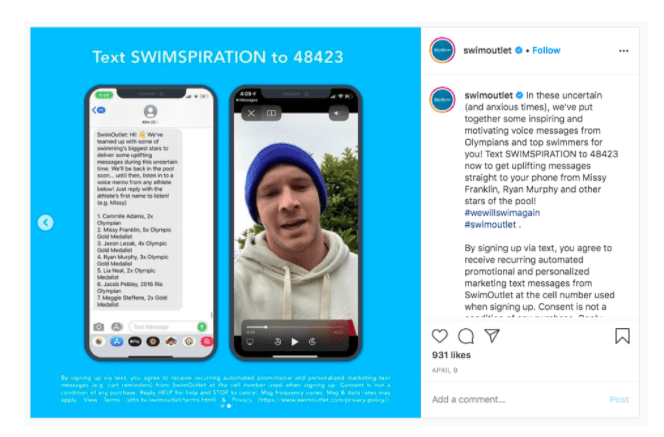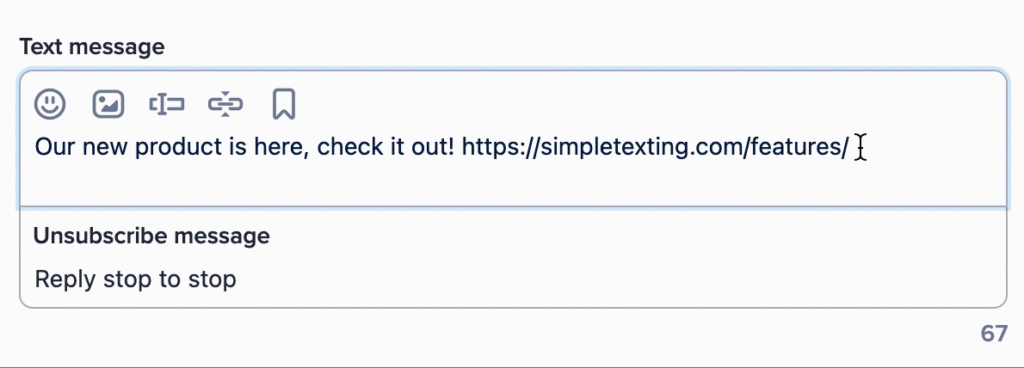What Are The Pros And Cons Of SMS Marketing? Explore the Advantages and Disadvantages
With many businesses adopting text message marketing, you might be wondering if you should, too. Here's a list of the pros and cons of SMS marketing to help you make up your mind.
Let’s address the elephant in the room: Why would you listen to me on the subject of the pros and cons of SMS marketing? I work for a business texting company, obviously I’m biased.
Okay, yes. But I’ve also done hours of research on why business owners love SMS marketing (and why some don’t).
The fact is, SMS isn’t going anywhere. We recently wrote about why SMS marketing is not only still relevant, but a major marketing trend.

Between the declining performance and rising costs of other popular digital marketing channels, SMS is experiencing a significant resurgence.
In 2022, 55% of businesses used text message marketing with their customers, showing a 27% year-over-growth in SMS adoption.
With so many businesses planning to try out text message marketing, you might be wondering if it’s right for you.
To help you get a handle on whether to invest your time—and budget—in texting, I’ve compiled a list of the pros and cons of SMS marketing.
SimpleTexting is SMS marketing software
How do businesses use SMS marketing?
Before I delve into the specific pros and cons of SMS marketing, here’s a quick snapshot of some of the most common SMS marketing service use cases.
- Mobile coupons or discount codes: Coupons and discount codes are the bread and butter of text message marketing. Businesses send texts with coupons to encourage their subscriber list to visit their store or shop online.
- Limited-time discounts or flash sales: As you’ll see, one of the advantages of SMS marketing is its immediacy. Brands use text messaging to drive immediate purchases with limited-time discounts and flash sales.
- Weekly/monthly specials or VIP clubs: SMS marketing can encourage loyalty with weekly or monthly specials to customers. Some even take it a step further by creating a VIP text club.
- Events: SMS marketing provides an effective way to build brand awareness, attract a more robust audience, and increase event attendance without breaking the bank.
- Sweepstakes: Encourage new signups with rewards through the use of sweepstakes.
- Polls: Businesses use SMS polls to give customers a voice and let them cast a vote.
This is by no means an exhaustive list. Businesses of all industries and sizes use SMS marketing to achieve different objectives.
For example, SwimOutlet used texting as a sales channel to send promotions to customers. This year it also began to use text messages to deliver audio and video messages from Olympic athletes such as Ryan Murphy, a three-time Olympic gold medalist in swimming.

If you want to learn about different ways businesses use SMS, I recommend you check out our customer success stories or read through the SMS industry guide that pertains to you.
The pros of SMS marketing
Now that we’ve gone over the uses of SMS marketing, let’s cover the reasons why 73% of business owners plan on increasing their SMS budget.
The advantages of SMS marketing:
- Subscribers buy from text messages at conversion rates as high as 45%.
- Many people open, read, and respond to texts within three minutes.
- SMS marketing is cost-effective.
- 72% of consumers will engage with personalized text messages from businesses.
- You can track, measure, and optimize your SMS marketing performance.
- You can stand out with your customers instead of only using social and email channels.
- Consumers want to receive your texts.
Here are a few pros of SMS marketing:
1. High conversion rates
Studies show that the conversion rates of SMS campaigns can be as high as 45%. (That represents the top end of the spectrum.)
When we take the average across different SimpleTexting customers and third-party studies, we see that the conversion rate hovers around 29%.
Compare this to the average conversion rate for other digital marketing channels:
One of the significant advantages of SMS marketing campaigns is that they drive conversions. It’s why Toroe Eyewear generated a 156x return on its SMS messaging.
“We set up the widget, created a 10% discount for subscribers, and the code has generated an extra $7,028.01 in store revenue within 30 days. That’s 156x return on the cost of sending the texts–we recommend it!” –Walter Castillo
2. People open, read, and respond to texts quickly
Beyond sky-high conversion rates, people open, read, and respond to texts quickly. You may have heard before that the open rate of text messages is 98%.
But it’s not that people eventually open their texts, 90% of people read a text message within the first three minutes of receiving it.
When you combine those numbers, you have the perfect channel for flash sales or time-sensitive offers. It’s why the Barn Bowl & Bistro uses text marketing to respond to downtimes and immediately bring in customers.

3. It’s cost-effective
SMS marketing is a very affordable channel. That comes as a surprise to most marketers, who expect the cost of sending texts to be prohibitive.
Each text marketing platform has its own rates, but with SimpleTexting, you can send 500 SMS messages for $29. As we already mentioned, the average conversion rate of an SMS campaign is 29%.
If your store’s average order value is $10 and you send a text blast to 500 contacts, you’ll generate $1,450 in revenue. That’s a 5,000% ROI.
4. Text messages are personal
SMS is a channel that people use to communicate with close friends and families. When your business gains access to someone’s inbox, it takes up the same real estate. Right off the bat, it’s a personal channel.
You can take it a step further by incorporating personalization into your text marketing strategy. If you’re wondering why you should care, 72% of consumers say they’ll only engage with marketing messages if those messages are tailored to their specific interests.
5. You can track, measure, and optimize performance
We wrote a step-by-step guide to tracking revenue from SMS campaigns. Most SMS marketing platforms offer some level of reporting, and SimpleTexting provides a user-friendly dashboard that makes it easy to see how your campaigns are performing.
You can also track the click-through rate of your campaigns using our link shortener.

6. SMS marketing presents a “Blue Ocean” marketing opportunity
In a book called Blue Ocean Strategy, Chan Kim and Renée Mauborgne came up with the term “blue ocean” to describe markets that represent ample opportunity for growth.
While the authors weren’t talking about marketing channels, the concept can be co-opted nicely for thinking about how to invest your marketing budget.
Customer acquisition costs for channels like paid social are on the rise, which is one of the reasons texting is growing in popularity.
The fact is, brands are searching for new places to talk to customers. Specifically, they’re looking for places where customers aren’t yet sick of hearing from them. SMS marketing is the answer.
Channel preference studies show that customers want businesses to text them. That demand plus the ease of use makes it a winning combination.
7. Customers want to receive your texts
We wrote about this advantage in an article on why text message marketing is so effective. The TL;DR is that since people subscribe to receive your texts, your message is guaranteed to reach an audience genuinely interested in what you have to offer.
It goes a long way to explain the high level of engagement and conversion rates businesses see when they send texts.
The cons of SMS marketing
You may have heard that your customers find text messages invasive. We’ve found that this can be easily mitigated by following a few straightforward best practices for SMS marketing.
However, this isn’t to say that text message marketing is perfect. Like any form of communication, it has its downsides.
Disadvantages of SMS marketing:
- You’ll have to manage a new channel.
- You’ll have to grow your SMS contact list.
- You can’t “set it and forget it”.
Here are a few cons of SMS marketing:
1. You have to manage a new channel
It’s a multi-channel marketing jungle out there.
Inspirational Instagram posts—tick. Facebook recommendations—tick. Trending TikToks—tick. Emails—tick.
It’s exhausting.
Throwing a new channel into the mix can pose a challenge to business owners and marketers already wearing a lot of different hats.
Luckily we have a series of step-by-step videos and help center articles to help you get the hang of things quickly. Our support team is also at the ready seven days a week to answer any questions.
2. You need to grow your list
With text marketing, you need people to text. It sounds obvious when you put it like that, but it’s something that businesses overlook when considering SMS as a new channel.
The good news is that we offer tons of different ways to grow your SMS subscriber list. Here are a couple of the fastest ways to grow a list:
- Keywords: Keywords are words or phrases that customers can text to your text-enabled phone number to express their interest in receiving your messages. For example, a company that sells running shoes online could invite you to text “RUN” to 123123.
- Web form: With SimpleTexting, you can use our web sign-up form to let website visitors subscribe to your text marketing campaigns by entering their information and clicking Subscribe Now.
- Mobile signup widget: Our mobile signup widget makes it effortless for visitors to your website to text in your keyword.
When visitors click on a trigger button, it opens a pop-up with more information on your text marketing program. When they click the button within the pop-up, their native text app opens with the keyword and number prefilled. All they have to do is hit send.

3. You can’t “set it and forget it”
There are very few—if any—marketing channels you can set and forget. Even marketing automation tools require constant monitoring and tweaking to ensure that you’re getting the most bang for your buck.
To be an effective SMS marketer, you need to collect phone numbers from your target audience. Then you need to keep these contacts interested with different calls to action (CTAs). Sending the same 160-character promotional message or coupon every two weeks is a surefire way to make your contact unsubscribe.
It’s why we constantly post articles on our Navigating SMS blog. We want to provide all the tips and inspiration you need to send fresh campaigns.
If you’re feeling overwhelmed by the idea of creative SMS marketing, here are seven unique SMS marketing examples to inspire your next campaign.
Everything has its pros and cons
No marketing channel is free from cons.
However, as you can see from the above, the pros of SMS marketing outweigh the cons. If you’re still not sold, you can always try out text marketing for two weeks at absolutely no cost. We don’t even ask for your credit card.
If you have questions about the pros and cons of SMS marketing, our team of experts would love to answer them. We’re available 7 days a week. Text or call us at (866) 450-4185 or use the chat at the bottom of your screen.
This piece was originally published June 17, 2020. It was refreshed and repurposed May 30, 2023. Drew Wilkinson originally authored this piece.